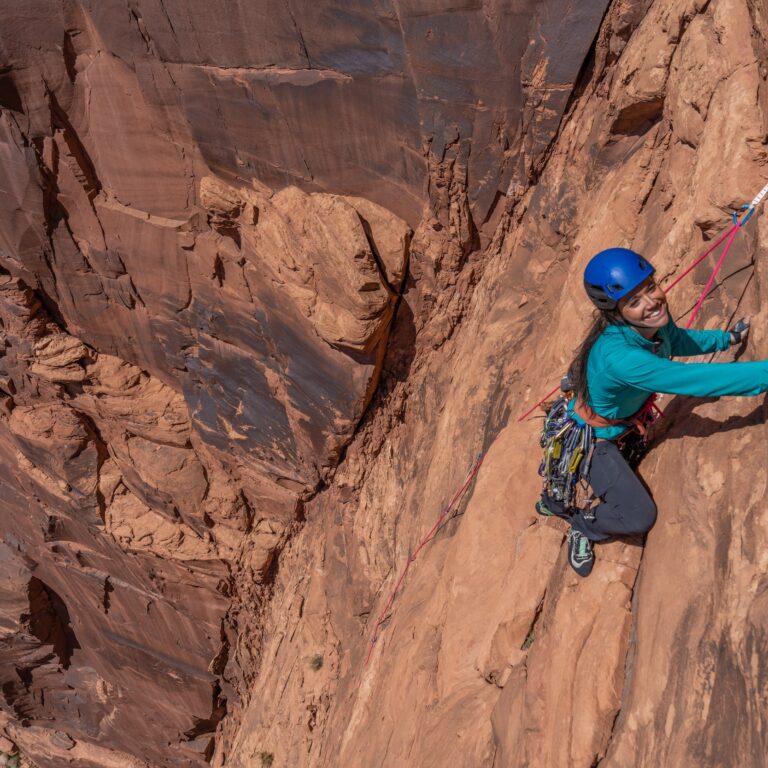As my ice climbing season draws to a close, I start to focus on climbing goals for later in the year. Spring is the perfect time to start training for summer alpine and rock goals!
Here is how I like to come out of hibernation:
First, I like to set my goals and devote time to achieving them. If my goal is to climb a particular grade, I need to pick out some goal routes. Depending on the particular route/objective, I want to commit to times and frequency. If I’m reaching for a particular grade sport route, I might make travel plans to Lander, WY for three weeks. Goal-setting and scheduling allows me to build a training plan for the time I have now, in order to reach my goal. Often, I schedule smaller goals along the way.
If you’re new to training, it helps tremendously to seek professional coaching. This helps to assess your goals, and tailor a training plan specifically from where you are to where you want to be. Hiring a professional also helps with accountability! Whether I’m going it alone, or following a professional training plan, I usually consider these three areas: aerobic/endurance training, strength & mobility, and goal specific training.
Most climbing goals or alpine objectives require an aerobic base. I build up my aerobic base by going on long runs, often uphill, at a pace I could comfortably talk at. I build my aerobic endurance by lapping easy routes at a climbing gym, spending 30 minutes on a treadwall, or lapping routes outside. A common climbing endurance exercise is 4X4’s, where I climb a moderate route 4 times, rest for 2-5 minutes, then climb another route 4 times and repeat until I‘ve climbed 16 laps in 4 sessions.
General strength and mobility are the most difficult exercises for me to force myself to do. I don’t enjoy stretching or lifting. In climbing we tend to compensate for weak or unstable parts of our body by over-using other parts; strength and mobility exercises prevent compensation injuries and improve our range of climbing movement. In a strength training session, I devote time to core: various planks (one arm, one leg lifted planks, side planks, twisting planks etc.), knee/leg lifts off of a pull-up bar or hangboard, and all sorts of variations on the abdominal crunch! When I’m doing upper body strength training, I incorporate pushing motion to counteract the disproportionate amount of pulling that climbing involves. My favorite pushing exercises are dips (slow, elbows tucked in) and push-ups. Lower body lifting includes barbell squats, barbell or dumbbell deadlifts, and dumbbell snatches. For mobility, I try to do yoga for at least 15 minutes each morning, working positions that open my hips and align my back and shoulders.
Training for a specific route or objective is unique to one’s goal. Overhanging routes require forearm endurance, speed, core tension, and high strength to body weight ratio. Long alpine routes require high aerobic threshold, weight training, overall endurance, and efficient climbing technique. I use goal specific training techniques when I know what the climb requires. Most of my climbing goals require increased finger strength. I accomplish this with hangboard workouts. I begin with a 15 minute warm-up to activate tendons which prevents injury. I follow with open hold shoulder shrugs or pull ups, weave my fingers upward through a bucket of rice, stretch my fingers back toward my wrist, and weight the hangboard holds with less than my full body weight. Once warmed up, a beginner hangboard workout takes place on half-crimp or open-crimp grips. The workout might involve 12 seconds hanging on half crimp grips, then 3 minutes of rest, repeated 5 times. Next, 5-10 minutes of rest then repeat the cycle 2-3 more times. If at anytime during a hangboard session my finger tendons ache, I stop. Hangboards are an easy place to get injured.
Set your goals, build your aerobic base, and train all spring long!

Katie Beringer
Katie is an avid rock climber, ice climber, skier, and runner. Originally from Arlington VA, she moved west in 2013 and to the San Juans in 2016 where she fell in love with the remote western slope. She has called Ouray home ever since. Katie is passionate about sharing the outdoors, especially rock climbing, with others. She has been professionally guiding rock and ice since 2016. Outside of Ouray, her favorite places to climb (and guide!) are the Black Canyon, Unaweep, Red Rocks, Joshua Tree, and the Red River Gorge. When guiding, she tries to expand her clients perceived physical or mental limitations, communicate the importance of outdoor recreation, and learn about others. Katie is also passionate about fitness and training for alpine goals. She is excited to work with clients who want to train for a specific objective, like summiting a peak via a difficult route, or a fitness goal, like climbing 5.12. Katie is an AMGA certified Rock Guide.

